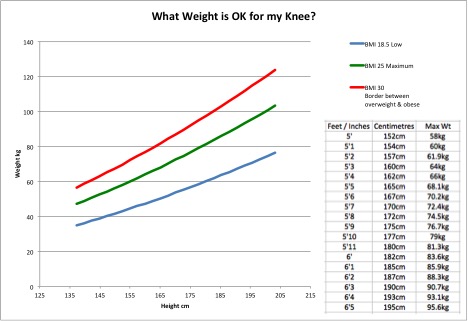The knee joint carries nine times your body weight as you use stairs. The hip uses 3.3x your body weight with every step. This is because of the amazing mechanics of the body, but it does have a downside – If you are overweight, you’re overworking your joints.

This graph shows with the green line, your maximum weight for a normal BMI. BMI’s are argued about for a general health point of view. Its is likely with a BMI of 30 you will still have a normal life expectancy, but your knee joint will not. Even if you’re 6’6, 198cm, your knee will eventually struggle if you weigh 100kg.
Some people do not accept the target weight based on their height and a BMI of 25, and come up with ten reasons why they can’t get to that weight But we would like you to have a target weight, and make a plan as to how to get there. The good news is that dropping 8 kilos for most people means the knee pain will improve. Some people will find that exercise and a small weight reduction fixes their knee pain, diabetes, hypertension, and cholesterol.
At the very least, being Strong, Supple and Slim will make you healthier.
If you’re serious about losing weight, you’ll need help. The Michael Mosley book – “The Fast 800” is an easy read plan as to how to lose weight. Mosley initially wrote about the 5:2 diet, this takes the idea further, but gives you a few more calories! You will need to calorie count at least two days per week. You should aim aim to introduce time restricted eating. It is easier if you enlist the help of your family and the people you usually eat with.

Mr David Mitchell
Orthopaedic Surgeon
References:
Mosley, Michael. The Fast 800. 2019. Simon and Schuster (Australia)
Brukner, Peter. 2018. “Fat Lot of Good”. How the experts got foot and diet wrong and what you can do to take back control of your health.”

